Trim
| Trim Irish: Baile Átha Troim | |
| Meath | |
|---|---|
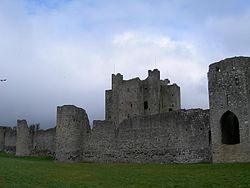 Trim Castle | |
| Location | |
| Grid reference: | N800567 |
| Location: | 53°33’8"N, 6°47’36"W |
| Data | |
| Population: | 8,268 (2011) |
| Local Government | |
Trim is a town in Meath, standing on the River Boyne. The town is noted for Trim Castle - the largest Cambro-Norman castle in Ireland. It was once known as the county town, but today that honour is claimed by Navan. St Patrick's Cathedral is located north of the river; reputedly Ireland's oldest.
The name is from the Irish language Baile Átha Troim, meaning "Town at the ford of elderflowers".
History
At an early date, a monastery was founded at Trim, which lay within the tribal kingdom of the Cenél Lóegairi. It is traditionally thought to have been founded by St Patrick and left in the care of its patron saint Lommán, also locally known as Loman, who flourished sometime between the 5th and early 6th century.[1] When domestic politics endangered the position of Lommán's foundation, the church of Armagh assimilated Lommán into the dossier of St Patrick, making him a disciple of that saint.[1]
Attackers burned the church several times in the twelfth century, during which it was refounded as an St Mary's Abbey under Augustinian rule. In the Middle Ages the abbey church was the sanctuary for "Our Lady of Trim", a wooden statue reported to work miracles, which statue made Trim a major pilgrimage site from at least 1397. During the Reformation, the statue was burned and Henry VIII dissolved the abbey. The abbey's bell tower, the "Yellow Steeple", is the primary remnant of St. Mary's.
On the River Boyne banks, Trim became one of the most important Hiberno-Norman settlements in the Middle Ages. In the 15th century the Irish parliament met in Trim. Arthur Wellesley, 1st Duke of Wellington is reputed to have been born in Dangan Castle between Trim and Summerhill, and a large column to him was erected in the town in 1817.
The town's main feature is Ireland's largest Norman castle, Trim Castle; other features include two ruined church complexes, the Boyne River for fishing and the Butterstream Gardens, visited by Charles, Prince of Wales in the mid-nineties (no longer open to the public).
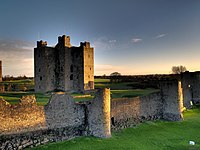
Trim Castle (or King John's Castle) is Ireland's largest Norman castle. It was built in the late 12th century following the Norman invasion of Ireland. Trim and the surrounding lands were granted to Hugh de Lacy, Lord of Meath, a Norman baron. Richard II of England stayed there before he was deposed by Henry Bolingbroke on his return from campaign.
Early modern period
Once a candidate to be the country's capital, the town has also occupied a role as one of the outposts of the Pale, and sessions of the Irish Parliament were sometimes held here, as in 1542. It was also designated by Elizabeth I of England as the planned location for a Protestant University, but this plan was revised by Sir Francis Drake, who advocated the case for locating the University in Dublin, and so Trinity College, Dublin was founded.
In 1649 after the sacking of Drogheda, the garrison of Trim fled to join other Irish forces and the town was occupied by the army of Oliver Cromwell. There were many local disturbances in neighbouring villages in the Irish Rebellion of 1798, most infamously the battle on the Hill of Tara, following the dispersal of the Wexford rebellion. Trim was represented in the Irish Parliament from 1790 to 1797 by Arthur Wellesley, who went on to become the 1st Duke of Wellington.
Nineteenth and twentieth centuries
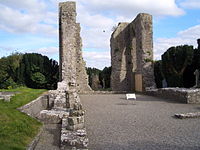
The 19th century saw the construction of Trim Courthouse, St. Loman's Catholic church, St. Patrick's Anglican church, the Wellington column, the current Bank of Ireland building, and Castle Street by Lord Dunsany, a major landowner. Following the Great Irish Famine of 1846–1849, the practices of agriculture in the hinterland altered, with a change in emphasis from tillage to stock raising. This resulted in a change in the business life of Trim. Trim developed as a market town for the productive agricultural hinterland. Some small-scale local industries were developed including envelope, and leather product manufacturing. Trim was also chosen as location for the Timoney Engineering company to make Fire Tenders. However in the main the town continued to mainly be a service centre for its immediate area.
During the Irish War of Independence, local companies of the Irish Republican Army took Trim RIC Barracks, a large structure located on the current site of the Castle Arch Hotel, secured the arms from the barracks and then burnt down the Barracks. A large part of the town was burned as a reprisal by the British Crown forces on 26 September 1920.[2] The local members were drawn from Trim, Longwood, Ballivor and South Meath in general. The Lalor brothers form Castle St. were prominent members as well as the Duignans from High Street and the Proctors. Records of the adventures of the Lalors rest in Navan library and recount the tales of one of the Bothers hiding in a recently dug grave in the churchyard. Local memories remember the townspeople sheltering down by the Boyne for a few nights as the Black and Tans and Auxiliaries burnt out prominent business and the Town Hall. Footage of the burning of J&E Smyth can be viewed on the 'Pathé' website. Many of the townspeople were traumatised for the rest of their lives; many children in Trim were not allowed play with guns; memories of the Black and Tans dangling grenades outside their windows as the Town Hall burnt and peeled the paint off their doors at Castle St. remained for a long time. The New York Times reported the burning of the barracks and the subsequent looting and burning of the town and follow up operations by the local IRA.
A new bridge was built on the Boyne in the 1980s to divert heavy traffic from the town. This was then enhanced by the construction, in a series of stages, of an inner relief road, which now makes it possible for heavy traffic to achieve a complete by-pass of the town. The Watergate bridge was replaced in 2005. The local town council purchased a field beside the new bridge in 2004, as it was expected to be of archaeological significance.
As part of the Civil Service decentralization plan of the Irish government, Trim was chosen as the location of the headquarters for the state body known as the Office of Public Works. The movement of this state administration function to Trim resulted in Trim being the first location outside of Dublin to complete a satisfactory decentralization move. Trim has seen some growth in recent years with growth as a tourist and business centre.
Places of interest
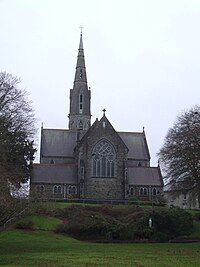
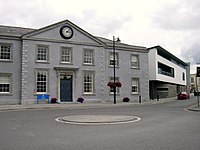
- St Patrick's Cathedral (Church of Ireland), Loman Street. It is reputed to be the oldest Anglican church in Ireland (disputed by a church in Armagh which claims its 20 years older than the Trim Church). The original church lies in ruins behind the current newer church which faces onto Loman Street from behind a large boundary wall.
- St Patrick's Church (Roman Catholic), Church Street
- Trim Castle, the largest Cambro-Norman castle in Ireland which was built by Hugh de Lacy, Lord of Meath.
- The Town Hall, known locally as the Market House.
- The yellow steeple (named so for the way the sun sets and rises on it in the giving it a yellow colour), the remains of a 14th century abbey on a hillside near the town centre, is the tallest building in Trim and can be seen for miles around the town.
- Trim Town Walls - Though not much remains of the original walls of Trim, the "sheep's gate" stands near the 'yellow steeple' and the castle. The wall in this area is in ruins but it marks the original town boundary, the only intact part of the wall stands on Loman Street It is not marked by any signs but it starts around the front of St. Patrick's Anglican church and runs down to 'The Priory Pub'.
- The Black Friary - A 13th century Dominican Friary located just outside the town walls. The excavation of the remains of the friary is part of the Blackfriary Community archaeology project.
- The Boyne river walk is a walkway along the river Boyne starting at the castle park and running along the Boyne to Newtown abbey. The total walk to Newtown and back takes about 40 minutes.
- Newtown Abbey lies on the banks of the Boyne about 15 minutes' walk from Trim Castle. It once was the largest Abbey of its kind in Ireland. It is still used as a graveyard for the town so there are no guided tours but there are lots of Information boards with pictures of what certain areas used to look like.
- St. John the Baptist hospice lies across the Boyne from Newtown abbey. This structure is again free access. At the entrance there is a defence tower which used to form part of the walls of the hospice.
- Trim Circuit Courthouse - Built in the 19th century, the courthouse overlooks the main street of the town. Recently extended with an award winning design, the courthouse is located next to the main entrance of the castle.
Events
Trim Car Show
An annual classic car show takes place in Trim every July, Trim Veteran and Vintage Rally has been running since 1985. It started in a small yard on Loman Street with just 1 car. The founder, Norman Pratt, determined to expand the show, approached the Roundtree family who very kindly allowed The Porchfields to be used on the day. It has grown each year since then and there are now in excess of 500 cars and motor cycles on show. Visitors to the show can also try their hand at archery with Athboy Archery Club. The archery has always been a big success at the fair.
Trim Haymaking Festival
Trim Haymaking Festival is held in the town every mid-June. The Porchfields, an amenity space rich in historic value, are home to a fair, market, and cultural displays. The main event is the traditional making of the first hay of the year by hand and by old-style machinery.Visitors to the show can also try their hand at archery with Athboy Archery Club. The archery has always been a big success at the fair.
Trim Swift Festival
Because of Jonathan Swift's residence near Trim after 1700, a satirical festival is held in his honour.[3]
Royal Meath Show
The Royal Meath Show takes place annually in porch field on the first Sunday in September each year. The main event of this agricultural show are judging of livestock, dogs and home industries and there are also trade stands and vintage machinery and many other attractions. 2012 will see the 72nd annual agricultural show in Trim.
Media
The town has been used as the location for some film productions, including the use of Trim Castle to depict York Castle in Mel Gibson's Braveheart.
Trim was also the setting for the first full-length Irish martial arts movie Fatal Deviation. (A low-budget production from 1998 that tells the story of a young man trying to rebuild his life after returning from reform school only to be harassed by a gang of local drug dealers.)
The 1980 movie The Big Red One, starring Lee Marvin and Mark Hamill, was also partially shot in Trim and in particular Trim Castle.
Outside links
| ("Wikimedia Commons" has material about Trim) |
- Meath Event Guide
- Travel Review of Trim and its attractions on VirtualTourist.com
- Trim information & photographs
- The Tidy Towns of Ireland "Celebrating 50 years"
- Trim & District Chamber of Commerce
- Trim Tidy Towns
References
- ↑ 1.0 1.1 Stalmans and Charles-Edwards, "Meath, saints of (act. c.400–c.900)"
- ↑ Anglo-Celt, Saturday, October 02, 1920
- ↑ "Trim Swift Festival". Trim Swift Festival. 2011-07-03. http://www.trimswiftfestival.com/. Retrieved 2012-02-13.
www.boynevalleyactivities.ie
- Stalmans, Nathalie and T.M. Charles-Edwards (September 2004; online edition, May 2007). "Meath, saints of (act. c.400–c.900)". Oxford Dictionary of National Biography. Oxford University Press. http://www.oxforddnb.com/view/article/51010. Retrieved 14 Dec 2008.
